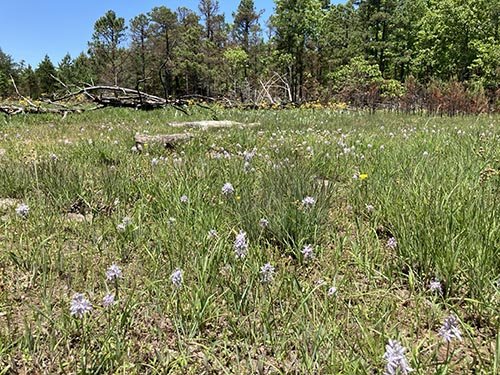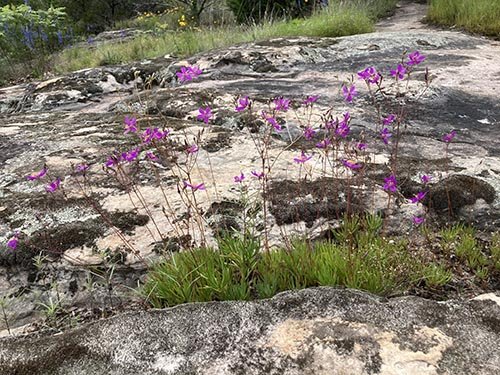The August 1, 2022 SGI newsletter featured a note about our field botany team discovering a “new” population of the rare Menges’ fameflower (Phemeranthus mengesii) in a rock outcrop grassland remnant in the Cumberland Plateau of Tennessee.
That got me thinking about all the cool plants in that genus, and about drought adapted plants of glades and other rock outcrop grasslands in general. And now that we’re in the hottest part of the year, these seemed like good topics for a blog post.
Extreme habitats
Glades and other rock outcrop grasslands are some of the most extreme habitats in eastern North America. They are characterized by hot, dry conditions during the summer months. Along with sand dunes and some types of exposed cliffs, they’re pretty much our hottest and driest habitats, with summer temperatures near the ground sometimes exceeding 140ºF.
Given the harsh conditions, these natural communities are home to some of our toughest and most resilient plants. Even the casual observer will notice “desert plants” like prickly-pear cactus (Opuntia spp.) and yucca (Yucca spp.) that may seem oddly out of place in the rainy Southeast. In fact, all plant species that live in the thinner-soiled zones of these habitats have some adaptation(s) to help them survive the intense heat and drought of summer.
A large population of Atlantic camas or wild hyacinth (Camassia scilloides) in a sandstone glade in the Ozarks’ Boston Mountains. These plants are well-adapted to seasonally hot and dry glade conditions by having succulent leaves and a fleshy bulb capable of storing water and carbohydrates. Photo credit: Theo Witsell
Plant adaptations to intense heat and drought
Avoidance
Many of the species found in glades and other rock outcrop grasslands are annuals and just avoid summer altogether. They germinate, grow, flower, and set seed during the cooler, wetter seasons and then die by summer, only to come back as a new generation from seed the next growing season.
Resist water loss
Some species, like the woolly lipfern (Myriopteris tomentosa), have woolly leaves with small divisions or segments that resist water loss. Some species have physiological adaptations such as CAM photosynthesis. CAM photosynthesis is a metabolic pathway that allows the plants to photosynthesize during the day but only respire through the leaves at night, when there is less risk of water loss.
Store resources
Other adaptations to heat and drought are more obvious. Some perennial species, for example, have fleshy bulbs below the ground which can store water and carbohydrates. (Water to prolong growth into the summer months. Carbohydrates to survive extended periods of dormancy when conditions become too rough to keep leaves alive.) Examples of these bulbous perennials include several native wild onions (Allium spp.), wild hyacinths (Camassia spp.), sunnybells (Schoenolirion spp.), and, west of the Mississippi River, death camas (Toxicoscordion nuttallii).
Other species are succulents that store water within fleshy leaves and stems. Examples of these include false aloe, or eastern agave (Manfreda virginica), elf orpine (Diamorpha smallii), several species of stonecrops (Sedum spp.), and one of my favorite genera of all, the rock-pinks or fameflowers (Phemeranthus spp.), which deserve more space than we could give them in the newsletter.
Succulent leaves of rock-pink or fameflower (Phemeranthus sp.). Photo credit: Theo Witsell
Hotspots for plant diversity
Glades and other rock outcrop grasslands are notorious hotspots (yes, pun intended) for plant diversity. They include concentrations of both rare and endemic species but are also important sites for new species discoveries.
Hiding in plain sight
Certain groups of plants are known, or at least suspected, to harbor undiscovered “cryptic diversity” waiting to be untangled. “Cryptic diversity” refers to two or more species that look so similar that, based on looks alone, they are often mistaken for a single species. The rock-pinks are a good example.
Rock-pinks / Fameflowers
These amazing plants have basal clusters of cylindrical, fleshy leaves on a short, tough stem. Stiff, wire-like stalks extend up and are topped by clusters of pale to hot pink, five-petaled flowers that only last a few hours.
The flowers (and the resulting fruits and seeds) differ between species. Characteristics such as petal size, stamen number, seed size, seed color, seed texture, and even the time of day that the flowers open can be important in identification.
Rock-pinks are beautiful and interesting in and of themselves, but they are also generally indicators of a good quality remnant ecosystem. Where you find rock-pinks you are also likely to find other uncommon and interesting species.
Stand of rock-pink or fameflower (Phemeranthus sp.) in a sandstone glade in the White River Hills Ecoregion of the Ozark Highlands. Photo credit: Theo Witsell
Rock-pink cryptic diversity
The Biota of North America Project (BONAP) lists seven species of Phemeranthus from the SGI focal region, but this number will almost certainly increase as ongoing studies (hopefully) “crack the code” of their cryptic diversity and new species are described.
For example, more than two decades of field work in glades and barrens in the Interior Highlands (the Ozark Plateaus, Arkansas Valley, and Ouachita Mountains) and adjacent West Gulf Coastal Plain have convinced me that there are multiple rock-pink entities in these areas that aren’t particularly good fits for any of the known species. Several of these apparently have narrow ranges and are likely restricted to glades on a particular rock type or to a particular small ecoregion.
In at least a few glades in that region, more than one species of rock-pink occur together. Once I was in a rare type of igneous glade in central Arkansas from mid-afternoon through the evening and witnessed two species reveal themselves.
When I arrived at the site the glades were showy with large hot pink flowers of what Arkansas botanists have historically called largeflower fameflower or rock-pink (Phemeranthus calycinus). I explored the site and cataloged plants for a couple of hours.
At one point, around 6:00 pm, I noticed that there were a lot of shorter plants with smaller, paler pink flowers mixed in. Closer inspection revealed that the flowers on these were still opening and were quite different, with smaller and paler pink petals and with just five stamens per flower (as opposed to many stamens on the larger plants).
These smaller evening-bloomers were smallflower fameflower or sunbright (Phemeranthus parviflorus). If I hadn’t stayed out botanizing through dinner, I likely would have never noticed them.
A rock-pink or fameflower (Phemeranthus sp.) from shale barrens in the Ouachita Mountains with exceptionally large flowers (note quarter for scale). Photo credits: Living plant photo (left) by Eric Hunt. Flower photos (right) by Theo Witsell
Reasons why the genus isn’t better understood
There are probably several reasons that the cryptic diversity of this genus hasn’t been untangled in the Interior Highlands (and likely elsewhere). For one thing, some of the entities are apparently only found in rare habitats, of which few examples exist, and even fewer have been explored by botanists with a particular interest in the genus.
Second, at least some of the features needed for examination (intact flowers and fruit, mature seeds, and information on the overall growth habit of the plant and time of day of flowering) are often missing from individual herbarium specimens.
And lastly, herbarium specimens of this genus are notoriously brittle and many, especially older ones, are in poor shape, having fallen apart and lost important aspects of their form and structure.
What’s needed in the future
To really untangle what’s going on we need:
good photographs of living plants (whole plant shots as well as shots of open flowers to allow stamen counts) matched with collections of pressed specimens (ideally pressed using foam sheets to keep the plants from breaking up),
mature seeds, and
leaf tissue preserved in silica gel so DNA can be extracted for molecular analysis.
You can help unravel the mysteries
If you’re out in rocky or sandy grasslands and encounter rock-pinks, please consider taking abundant photos of various parts of the plants and posting to iNaturalist. Even if the pictures are only identified to the genus level, this information can be valuable to botanists working to unravel the diversity in this important genus.
Theo Witsell, SGI Chief Ecologist
Theo explores our native grasslands, gathers and synthesizes data on their ecological and historical significance, and provides scientific direction and ecological context for the Southeastern Grasslands Initiative.





